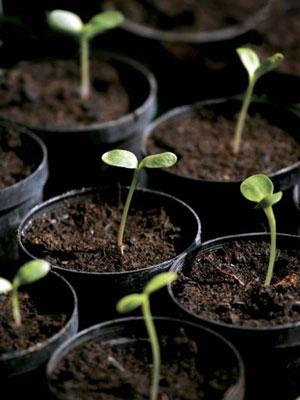March 16, 2009
By Susanne von Rosenberg, UC Master Gardener
 We’ve had so much warm weather in Napa County recently, it’s hard to remember that our typical last-frost date is actually April 15. Even so, it’s not too early to start some seeds indoors so that you’ll have seedlings ready when the soil has warmed enough. It’s also time to plant some seeds outside, such as peas, spinach, chard and radishes.
We’ve had so much warm weather in Napa County recently, it’s hard to remember that our typical last-frost date is actually April 15. Even so, it’s not too early to start some seeds indoors so that you’ll have seedlings ready when the soil has warmed enough. It’s also time to plant some seeds outside, such as peas, spinach, chard and radishes.Why start seeds yourself? Because it’s fun, you have more choices (one online tomato catalog lists more than 600 varieties), and you can save money. A typical seed package will last several years and produce lots of plants.
You can start seeds indoors and plant the seedlings in the ground later, or you can plant some seeds directly in the ground.
Seeds that are typically started indoors include broccoli, cauliflower, eggplant, parsley, peppers and tomatoes. Basil, cucumbers, lettuces and Asian greens, melons (if your growing season is long enough), onions, pumpkins, and summer and winter squash can be started in containers or in the ground. Seeds that are typically started in the ground include beans, beets, carrots, chard, peas and turnips.
Seeds that are typically started indoors include broccoli, cauliflower, eggplant, parsley, peppers and tomatoes. Basil, cucumbers, lettuces and Asian greens, melons (if your growing season is long enough), onions, pumpkins, and summer and winter squash can be started in containers or in the ground. Seeds that are typically started in the ground include beans, beets, carrots, chard, peas and turnips.
To germinate, seeds need water, oxygen, an appropriate soil temperature and, in some cases, light. For good drainage in containers, plant seeds in a commercial seed-starting mix. If you are planting the seeds outside, make sure your soil is loose and well aerated.
Seed germination begins when the seed takes up water from its surroundings. Once a seed begins germinating, a dry period will kill it.
All seeds have an optimal temperature range for germination. For most plants, that range is 65°F to 75°F. Seed packages will typically tell you if your seeds need light.
By starting seeds indoors, you can control the air temperature and the watering. You can also provide a sterile soil mix, which helps reduce the potential for fungal diseases. And if you space the seeds correctly, you won’t have to thin the seedlings. What’s more, you can nurture the seedlings indoors until they are large enough to withstand damage from insects, birds and other predators.
On the other hand, if you start seeds outdoors, they will not require transplanting and will receive plenty of light. However, the soil preparation is demanding and the environment much more challenging for the seeds. Insects, birds and other predators may eat the seeds or damage or destroy the seedlings. Heavy rains and strong winds can also harm seedlings.
You can start seeds in almost any container that has drainage holes. Sterilize used containers in a 10 percent bleach solution (1 part bleach to 9 parts water), and then rinse them well. Fill containers with your seed-starting mix to within three-quarters inch of the top, then firm and level it. Water well. Let containers drain to ensure that the medium is sufficiently wet but not saturated, then plant the seeds.
Most seed packets instruct you about planting depth, but typically, seeds want to be planted at a depth two to four times their diameter. Top them with a light layer of dry seed-starting mix. If possible, cover the containers with clear plastic bags or plastic wrap so that the medium remains moist. To speed germination, keep your seeds in a relatively warm (70°F - 75°F) area until they have germinated.
Once the seedlings emerge, move the containers to a cooler area near a bright light source, such as near a south-facing window or underneath full-spectrum fluorescent lights (grow lights). If using grow lights, position them approximately six inches above the seedlings. Water regularly; do not allow seedlings to wilt. Feed occasionally with half-strength fertilizer. Before planting them out in the garden, accustom them gradually to outdoor conditions by taking them out for successively longer periods every day.
To start seeds outdoors, carefully weed, rake and water the soil. If necessary, add fertilizer and amendments before planting. Check the soil temperature to make sure the soil is warm enough for the seeds. (Consult the seed packet for recommended soil temperatures.)
If your soil is good, plant seeds at the same depth as for indoor planting; in heavier soil, such as the clay soil common in Napa County, plant a little shallower. Cover seeds with fine soil, or use vermiculite if your soil is heavy. Mist daily until the seedlings emerge. Consider covering your newly planted seeds and seedlings with a fabric row cover to protect them from predators and heavy rains. Weed frequently to reduce competition, but weed carefully to avoid damaging the seedlings. You can take pride that you grew them from seed.
Seed Starting - University of California Garden Web
Seed Starting - University of California Garden Web
